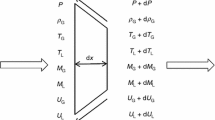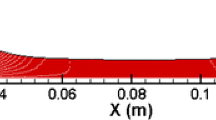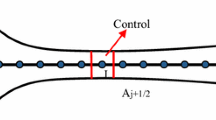Abstract
Because of limited energy resources, the examination of losses in industrial systems is very imperative. The energy and exergy analysis is considered one of the methods to evaluate losses. In aerospace and power engineering, supersonic nozzles have many applications. Their performance can be enhanced by means of the energy and exergy analysis. In the supersonic nozzles, the non-equilibrium condensation occurred. It is an irreversible process that engenders thermodynamic losses. In this investigation, to estimate the performance of supersonic nozzles, an analysis on the energy and exergy is provided. The influences of augmentation in the temperature of the inlet steam on the performance of the nozzle are elucidated. Accordingly, a 2D numerical simulation of the nozzle is presented. After validation of numerical results, the effects of increment of the temperature are researched. It is observed that as the temperature of the inlet steam is enhanced, a condensation shock with a delay is occurred, the nucleation area becomes smaller, and the liquid mass fraction is abated in the nozzle. Moreover, the mass flow inlet rate, energy consumption, and exergy destruction are diminished. As the temperature of the inlet steam is augmented by 40 °C, the liquid mass fraction, mass flow inlet rate, energy consumption, and exergy destruction are reduced by 28%, 4.6%, 1.3%, and 32%, respectively.












Similar content being viewed by others
Abbreviations
- \(B, C\) :
-
Second and third virial coefficients
- \(D\) :
-
Degree of supercooling
- \(E\) :
-
Total energy
- \(G\) :
-
Bulk Gibbs free energy change
- \(h\) :
-
Enthalpy
- \(J\) :
-
Nucleation rate
- \(k\) :
-
Turbulent kinetic energy
- \({K}_{\mathrm{b}}\) :
-
Boltzmann's constant
- \(m\) :
-
Molecular mass
- \(n\) :
-
Number of liquid droplets
- \(P\) :
-
Pressure
- \({q}_{\mathrm{c}}\) :
-
Condensation coefficient
- \(r\) :
-
Droplet radius
- \(R\) :
-
Gas constant
- \(t\) :
-
Time
- \(T\) :
-
Temperature
- \(u\),\(v\) :
-
Velocity components
- \(y\) :
-
Liquid mass fraction
- \(x\) :
-
Cartesian direction
- \(\rho\) :
-
Density
- \(\mu\) :
-
Dynamic viscosity
- \({\mu }_{\mathrm{T}}\) :
-
Turbulent viscosity
- \(\tau\) :
-
Viscous stress tensor
- \(\theta\) :
-
Non-isothermal correction coefficient
- \(\sigma\) :
-
Liquid surface tension
- \(\Gamma\) :
-
Mass generation rate
- \(\lambda\) :
-
Thermal conductivity
- \({\delta }_{ij}\) :
-
Kronecker delta function
- \(\varepsilon\) :
-
Turbulent dissipation rate
- \(\gamma\) :
-
Heat capacity ratio
- \(\varnothing\) :
-
Hardness coefficient
- \(l\) :
-
Liquid
- \(v\) :
-
Vapor
- \(lv\) :
-
Liquid–vapor
- \(s\) :
-
Saturation
- \(in\) :
-
Inlet
- \(0\) :
-
Stagnation
- *:
-
Critical condition
References
Aliabadi MA, Bahiraei M (2021) Effect of water nano-droplet injection on steam ejector performance based on non-equilibrium spontaneous condensation: a droplet number study. Appl Therm Eng 184:116236
Aliabadi MA, Lakzian E, Jahangiri A, Khazaei I (2019) Numerical investigation of effects polydispersed droplets on the erosion rate and condensation loss in the wet steam flow in the turbine blade cascade. Appl Therm Eng 4:114478
Aliabadi MA, Lakzian E, Khazaei I, Jahangiri A (2020) A comprehensive investigation of finding the best location for hot steam injection into the wet steam turbine blade cascade. Energy 190:116397
Aliabadi MA, Jahangiri A, Khazaee I, Lakzian E (2020) Investigating the effect of water nano-droplets injection into the convergent-divergent nozzle inlet on the wet steam flow using entropy generation analysis. Int J Therm Sci 1(149):106181
Aliabadi MA, Zhang G, Dykas S, Li H (2021) Control of two-phase heat transfer and condensation loss in turbine blade cascade by injection water droplets. Appl Therm Eng 186:116541
Aljundi IH (2009) Energy and exergy analysis of a steam power plant in Jordan. Appl Therm Eng 29(2–3):324–328
Ding H, Li Y, Lakzian E, Wen C, Wang C (2019) Entropy generation and exergy destruction in condensing steam flow through turbine blade with surface roughness. Energy Convers Manag 15(196):1089–1104
Ding H, Tian Y, Wen C, Wang C, Sun C (2021) Polydispersed droplet spectrum and exergy analysis in wet steam flows using method of moments. Appl Therm Eng 182:116148
Dolatabadi AM, Lakzian E, Heydari M, Khan A (2022) A modified model of the suction technique of wetness reducing in wet steam flow considering power-saving. Energy 1(238):121685
Dykas S, Wróblewski W (2011) Single-and two-fluid models for steam condensing flow modeling. Int J Multiph Flow 37(9):1245–1253
Ezzat MF, Dincer I (2020) Energy and exergy analyses of a novel ammonia combined power plant operating with gas turbine and solid oxide fuel cell systems. Energy 1(194):116750
Fürst J, Halama J, Hric V (2021) A pressure based solver for simulation of non-equilibrium wet steam flows. J Comput Appl Math 15(398):113653
Gerber AG, Kermani MJ (2004) A pressure based Eulerian–Eulerian multiphase model for condensation in transonic steam flows. Int J Heat Mass Transf 47:2217–2231
Hassan HZ (2013) Evaluation of the local exergy destruction in the intake and fan of a turbofan engine. Energy 15(63):245–251
Hosseinizadeh SE, Ghamati E, Jahangiri A, Majidi S, Khazaee I, Aliabadi MA (2023) Reduction of water droplets effects in steam turbine blade using multi-objective optimization of hot steam injection. Int J Therm Sci 1(187):108155
Mahpeykar MR, Teymourtash AR, Amiri RE (2013) Theoretical investigation of effects of local cooling of a nozzle divergent section for controlling condensation shock in a supersonic two-phase flow of steam. Meccanica 48(4):815–827
Mirhoseini MS, Boroomand M (2017) Multi-objective optimization of hot steam injection variables to control wetness parameters of steam flow within nozzles. Energy 15(141):1027–1037
Mugi VR, Chandramohan VP (2021) Energy and exergy analysis of forced and natural convection indirect solar dryers: estimation of exergy inflow, outflow, losses, exergy efficiencies and sustainability indicators from drying experiments. J Clean Prod 1(282):124421
Naskar MK, Barman N, Simlandi S (2022) Emission control exploring the energy and exergy analysis for turbines of a 500 MW coal-based conventional power plant. Mater Today Proc 1(49):2183–2188
Sabzehali M, Rabiee AH, Alibeigi M, Mosavi A (2022) Predicting the energy and exergy performance of F135 PW100 turbofan engine via deep learning approach. Energy Convers Manag 1(265):115775
Senguttuvan S, Lee JC (2019) Numerical study of wet-steam flow in Moore nozzles. J Mech Sci Technol 33(10):4823–4830
Sharshir SW, Peng G, Elsheikh AH, Edreis EM, Eltawil MA, Abdelhamid T, Kabeel AE, Zang J, Yang N (2018) Energy and exergy analysis of solar stills with micro/nano particles: a comparative study. Energy Convers Manag 1(177):363–375
Starzmann J, Hughes FR, Schuster S, White AJ, Halama J, Hric V, Kolovratník M, Lee H, Sova L, Št’astný M, Grübel M (2018) Results of the international wet steam modeling project. Proc Inst Mech Eng Part A J Power Energy. 232(5):550–570
Talebi Somesaraee M, Amiri Rad E, Mahpeykar MR (2018) Analytical investigation of simultaneous effects of convergent section heating of Laval nozzle, steam inlet condition, and nozzle geometry on condensation shock. J Therm Anal Calorim 133(2):1023–1039
Tanbay T, Durmayaz A (2022) Energy, exergy and ecological analysis and multiobjective optimization of the hydrogen-fueled Scimitar engine with fixed nozzle geometry. Int J Hydrogen Energy
Wang C, Wang X, Ding H (2018) Boundary layer of non-equilibrium condensing steam flow in a supersonic nozzle. Appl Therm Eng 25(129):389–402
Wen C, Karvounis N, Walther JH, Yan Y, Feng Y, Yang Y (2019) An efficient approach to separate CO2 using supersonic flows for carbon capture and storage. Appl Energy 15(238):311–319
Wen C, Yang Y, Ding H, Sun C, Yan Y (2021) Wet steam flow and condensation loss in turbine blade cascades. Appl Therm Eng 189:116748
Xu C, Wang Z, Li X, Sun F (2011) Energy and exergy analysis of solar power tower plants. Appl Therm Eng 31(17–18):3904–3913
Yang Y, Peng H, Wen C (2021) A novel dehumidification strategy to reduce liquid fraction and condensation loss in steam turbines. Entropy 23(9):1225
Young JB (1988) An equation of state for steam for turbomachinery and other flow calculations. J Eng Gas Turbines Power 110(1):1–7
Zhang G, Zhang X, Wang F et al (2019) Numerical investigation of novel dehumidification strategies in nuclear plant steam turbine based on the modified nucleation model. Int J Multiph Flow. https://doi.org/10.1016/j.ijmultiphaseflow.2019.103083
Zhang G, Dykas S, Majkut M, Smołka K, Cai X (2021) Experimental and numerical research on the effect of the inlet steam superheat degree on the spontaneous condensation in the IWSEP nozzle. Int J Heat Mass Transf 1(165):120654
Zhang G, Wang X, Pourranjbar D, Dykas S, Li H, Chen J (2022) The comprehensive analysis of the relationship between the latent heat, entrainment ratio, and ejector performance under different superheating degree conditions considering the non-equilibrium condensation. Appl Therm Eng 5(200):117701
Zhang G, Wang X, Dykas S, Aliabadi MA (2022) Reduction entropy generation and condensation by NaCl particle injection in wet steam supersonic nozzle. Int J Therm Sci 1(171):107207
Author information
Authors and Affiliations
Contributions
XH: methodology, software, validation, formal analysis. YM: writing—original draft preparation, conceptualization, supervision, project administration. XD: language review, methodology, software, validation.
Corresponding author
Ethics declarations
Conflict of interest
The authors declare no competing interests.
Additional information
Publisher's Note
Springer Nature remains neutral with regard to jurisdictional claims in published maps and institutional affiliations.
Rights and permissions
Springer Nature or its licensor (e.g. a society or other partner) holds exclusive rights to this article under a publishing agreement with the author(s) or other rightsholder(s); author self-archiving of the accepted manuscript version of this article is solely governed by the terms of such publishing agreement and applicable law.
About this article
Cite this article
Hui, X., Ma, Y. & Deng, X. Numerical simulation on effects of augmentation in temperature of inlet steam on wet steam flow in supersonic nozzle: energy and exergy analysis. Multiscale and Multidiscip. Model. Exp. and Des. 6, 723–732 (2023). https://doi.org/10.1007/s41939-023-00164-x
Received:
Accepted:
Published:
Issue Date:
DOI: https://doi.org/10.1007/s41939-023-00164-x




